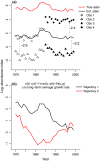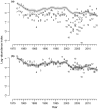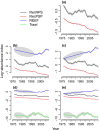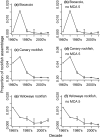Population assessment using multivariate time-series analysis: A case study of rockfishes in Puget Sound
- PMID: 28428874
- PMCID: PMC5395462
- DOI: 10.1002/ece3.2901
Population assessment using multivariate time-series analysis: A case study of rockfishes in Puget Sound
Abstract
Estimating a population's growth rate and year-to-year variance is a key component of population viability analysis (PVA). However, standard PVA methods require time series of counts obtained using consistent survey methods over many years. In addition, it can be difficult to separate observation and process variance, which is critical for PVA. Time-series analysis performed with multivariate autoregressive state-space (MARSS) models is a flexible statistical framework that allows one to address many of these limitations. MARSS models allow one to combine surveys with different gears and across different sites for estimation of PVA parameters, and to implement replication, which reduces the variance-separation problem and maximizes informational input for mean trend estimation. Even data that are fragmented with unknown error levels can be accommodated. We present a practical case study that illustrates MARSS analysis steps: data choice, model set-up, model selection, and parameter estimation. Our case study is an analysis of the long-term trends of rockfish in Puget Sound, Washington, based on citizen science scuba surveys, a fishery-independent trawl survey, and recreational fishery surveys affected by bag-limit reductions. The best-supported models indicated that the recreational and trawl surveys tracked different, temporally independent assemblages that declined at similar rates (an average of -3.8% to -3.9% per year). The scuba survey tracked a separate increasing and temporally independent assemblage (an average of 4.1% per year). Three rockfishes (bocaccio, canary, and yelloweye) are listed in Puget Sound under the US Endangered Species Act (ESA). These species are associated with deep water, which the recreational and trawl surveys sample better than the scuba survey. All three ESA-listed rockfishes declined as a proportion of recreational catch between the 1970s and 2010s, suggesting that they experienced similar or more severe reductions in abundance than the 3.8-3.9% per year declines that were estimated for rockfish populations sampled by the recreational and trawl surveys.
Keywords: Endangered Species Act; Sebastes; data‐limited; multivariate autoregressive state‐space models; population viability analysis; risk assessment; rockfishes; trend analysis.
Figures









Similar articles
-
Divergent Population Structure in Five Common Rockfish Species of Puget Sound, WA Suggests the Need for Species-Specific Management.Mol Ecol. 2025 Jan;34(1):e17590. doi: 10.1111/mec.17590. Epub 2024 Nov 25. Mol Ecol. 2025. PMID: 39587854 Free PMC article.
-
Advancing the use of local ecological knowledge for assessing data-poor species in coastal ecosystems.Ecol Appl. 2014 Mar;24(2):244-56. doi: 10.1890/13-0817.1. Ecol Appl. 2014. PMID: 24689138
-
Historical Patterns and Drivers of Spatial Changes in Recreational Fishing Activity in Puget Sound, Washington.PLoS One. 2016 Apr 7;11(4):e0152190. doi: 10.1371/journal.pone.0152190. eCollection 2016. PLoS One. 2016. PMID: 27054890 Free PMC article.
-
Actual and potential use of population viability analyses in recovery of plant species listed under the US endangered species act.Conserv Biol. 2013 Dec;27(6):1265-78. doi: 10.1111/cobi.12130. Epub 2013 Aug 23. Conserv Biol. 2013. PMID: 24033732 Review.
-
Emerging Issues in Population Viability Analysis.Conserv Biol. 2002 Feb;16(1):7-19. doi: 10.1046/j.1523-1739.2002.99419.x. Conserv Biol. 2002. PMID: 35701959 Review.
Cited by
-
Divergent Population Structure in Five Common Rockfish Species of Puget Sound, WA Suggests the Need for Species-Specific Management.Mol Ecol. 2025 Jan;34(1):e17590. doi: 10.1111/mec.17590. Epub 2024 Nov 25. Mol Ecol. 2025. PMID: 39587854 Free PMC article.
-
Lumpfish, Cyclopterus lumpus, distribution in the Gulf of Maine, USA: observations from fisheries independent and dependent catch data.PeerJ. 2024 Aug 14;12:e17832. doi: 10.7717/peerj.17832. eCollection 2024. PeerJ. 2024. PMID: 39157768 Free PMC article.
-
Establishing large mammal population trends from heterogeneous count data.Ecol Evol. 2024 Aug 22;14(8):e70193. doi: 10.1002/ece3.70193. eCollection 2024 Aug. Ecol Evol. 2024. PMID: 39184571 Free PMC article.
-
Documenting fishes in an inland sea with citizen scientist diver surveys: using taxonomic expertise to inform the observation potential of fish species.Environ Monit Assess. 2022 Feb 26;194(3):227. doi: 10.1007/s10661-022-09857-1. Environ Monit Assess. 2022. PMID: 35218441 Free PMC article.
-
Toward a conceptual framework for managing and conserving marine habitats: A case study of kelp forests in the Salish Sea.Ecol Evol. 2022 Jan 12;12(1):e8510. doi: 10.1002/ece3.8510. eCollection 2022 Jan. Ecol Evol. 2022. PMID: 35136559 Free PMC article.
References
-
- Agresti, A. , & Coull, B. A. (1998). Approximate is better than “exact” for interval estimation of binomial proportions. American Statistician, 52, 119–126.
-
- Ahrestani, F. S. , Hebblewhite, M. , & Post, E. (2013). The importance of observation versus process error in analyses of global ungulate populations. Scientific Reports, DOI: 10.1038/srep03125 - DOI - PMC - PubMed
-
- Andelman, S. J. , Groves, C. , & Regan, H. M. (2004). A review of protocols for selecting species at risk in the con‐ text of US Forest Service viability assessments. Acta Oecologica, 26, 75–83.
-
- Anderson, L. E. , Lee, S. T. , & Levin, P. S. (2013). Costs of delaying conservations: Regulations and recreational values of exploited and co‐occurring species. Land Economics, 89, 371–385.
LinkOut - more resources
Full Text Sources
Other Literature Sources
Miscellaneous

